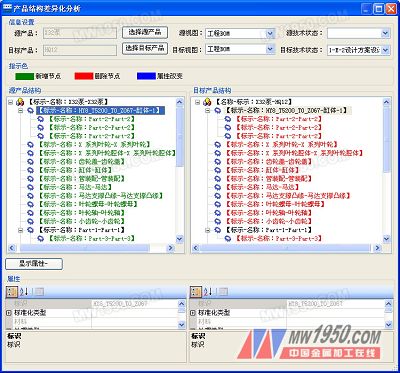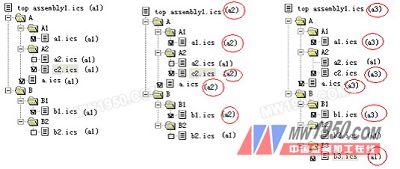
Figure BOM view differentiation analysis
When the source view is compared to the target view, the differences between the different entries in the view are distinguished by different colors, making the viewer clear at a glance.
5. Introduction to application system integration
The CAXA Collaborative Management solution integrates with multiple application systems, the most important of which include CAD integration and ERP integration.
5.1CAD integration
For 3D CAD systems, the CAXA Collaborative Management solution provides a unified, universal integration model and functional integration points for specific CAD systems.
In the 3D system, there are many types of data, such as Assem, Part, Drawing and other basic elements in Solid Works; in CATIA, the data types are: Assem for assembly entities; Part for parts; Drawing for drawings; Catalog for entity collections, Usually used to manage standard parts; ParaTable is a design parameter table; FeatureDic represents a feature dictionary; Appendix represents material, form and other ancillary information; Relation represents the constraints and reference relationships between the previous elements. The CAXA entity design includes elements such as 3D ICS, 2D ICD, and model library.
There are various relationships between various types of data in 3D systems, such as the composition relationship between assemblies and parts; the special relationship between 3D solids and 2D drawings; the relationship between analytical data and analytical objects; features and entities The relationship between the drivers and so on. The product data management system manages the static data of data elements and their relationships, and also manages the process of product data changes based on the relationship between the data. If you want to modify a part drawing, open its 2D drawing file, and determine the part to be modified on the 2D drawing page. When the modification operation is performed, the 3D CAD automatically opens the corresponding 3D model according to the relationship of the record. Only the 3D model is modified, the model is modified, and the system automatically modifies the 2D map accordingly.
Another feature of 3D management is the version management of the 3D model, that is, the management system can record a version of a set of 3D models corresponding to each time point, called a scene. A scene records in detail the version of each part in the 3D model, the overall assembly information, etc., so that the design can be rolled back according to the scene when needed.

Figure 3D assembly scenario management
In the figure, a1, a2, a3 are the versions of the ICS file. When scene 2 is saved, the version of a1.ics (a2), the version of c2.ics (a2), the version of b1.ics (a2), the version a2 of the assembly top assembly.ics, and the file structure under the top assembly are Completely saved.
For each scenario, a restore point can be created, which is a snapshot of the 3D file structure and the 3D file. Users can create multiple restore points for a 3D final assembly, and then the user can fall back to any one of the restore points. At a restore point, the system records the folder structure, external reference relationships, and working versions of the 3D files for the final 3D file.
For each of the different 3D systems, the CAXA Collaborative Management Solution provides further personalized management, such as Pro/E, which provides the ability to build a tree based on a 3D model and provides an online menu of Pro/E operations.
| Previous page | 1 | 2 | 3 | 4 | 5 | 6 | 7 | Next page |
Nanomicro Tech has developed black microspheres based on a proprietary composite of silica and polymer. These composite microspheres are intensely black and darker than other similar products on the market. Employed as a spacer in liquid crystal displays (LCD), the black microspheres not only control the thickness of the liquid crystal layer but also prevent leakage of light through the microspheres to improve the contrast of the LCD panel. When immersed or dispersed in a medium for the application, the dark color does not fade or leach out of the microspheres. Current production of the black spacer centers around mainstream sizes of 4.0 and 6.0 µm. When placing an order of the product of other particle sizes, a lead time should be considered.
Black Ball,Black Ball Beads,Spacer In Lcd Use
Suzhou Nanomicro Technology Co., Ltd. , http://www.nanomicro-technology.com